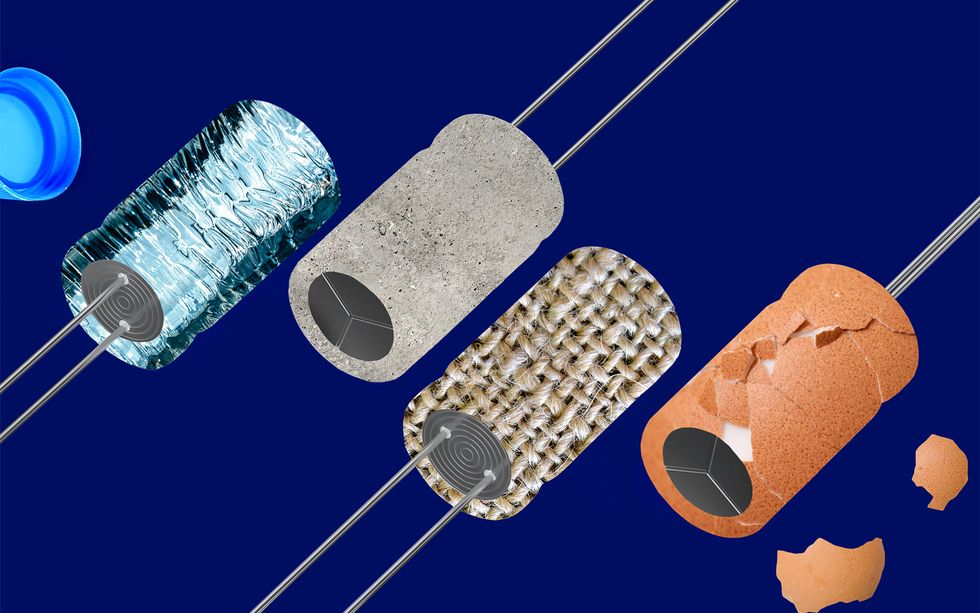Science
Researchers Create Supercapacitors from Unlikely Materials

Innovative research from various universities has demonstrated the potential to develop supercapacitors using unconventional materials such as water bottles, eggs, hemp, and cement. These energy storage devices offer rapid charging and discharging capabilities, making them suitable for applications requiring quick bursts of power. Unlike traditional batteries, supercapacitors have a greater capacity for instantaneous energy delivery, which positions them as valuable components in industries like manufacturing and data management.
Supercapacitors typically consist of two electrodes made from activated carbon or graphene, an electrolyte to facilitate ion movement, and a separator to prevent short-circuiting. When fully charged, positive ions accumulate on one side, while negative ions gather on the opposite side. The rapid switching between these states distinguishes supercapacitors from their battery counterparts.
Recent findings from the Michigan Technological University reveal that supercapacitors made from recycled plastic water bottles exhibit superior performance compared to conventional models. The team reported that these devices achieved a capacitance of 197.2 Farads per gram, surpassing the 190.3 Farads per gram achieved by traditional glass fiber separators. Yun Hang Hu, a materials scientist involved in the study, emphasized that this method offers a promising avenue for sustainable energy storage solutions.
Research into supercapacitor sustainability is not new. Yury Gogotsi, an expert in energy storage materials at Drexel University, noted that the rise of lithium-ion technology has historically overshadowed supercapacitors. Despite this, researchers remain optimistic about their potential. Hu stated, “There is a promising path to commercialization once collection and processing challenges are addressed.”
Innovative Applications of Everyday Materials
The development of supercapacitors from everyday items showcases remarkable resourcefulness. For example, a team from the University of Virginia demonstrated that supercapacitors could be constructed entirely from eggs. By utilizing eggshells, membranes, and the contents of the egg, researchers created electrodes, electrolytes, and separators through a series of innovative processes. The resulting supercapacitor maintained 80 percent of its capacitance after 5,000 cycles, highlighting the viability of using natural materials in energy storage.
Similarly, a group from Ondokuz Mayıs University in Türkiye explored the capabilities of hemp. By processing pomegranate hemp plants, they produced activated carbon for supercapacitor electrodes. Their findings indicated that the hemp-derived supercapacitor retained an impressive 98 percent of its capacitance after 2,000 cycles, demonstrating its competitive energy density of 65 watt-hours per kilogram.
The potential for cement in energy storage also emerged from research conducted by the Massachusetts Institute of Technology (MIT). The team created electrodes using a combination of water, carbon, and cement, claiming that this mixture enhances the electrodes’ ion retention capabilities. Their experiments revealed that these cement-based supercapacitors could theoretically store around 10 kilowatt hours, enough to meet approximately one-third of an average American’s daily energy requirements.
Future Prospects for Supercapacitors
While these advancements in supercapacitor technology are promising, experts caution against overestimating their immediate market availability. Historical trends show that despite interest in sustainable energy storage, supercapacitors have often been sidelined by the rapid advancements in lithium-ion batteries.
Nevertheless, the innovative approaches to utilizing unconventional materials could pave the way for a new generation of supercapacitors. As researchers continue to explore the capabilities of various substances, the potential for eco-friendly and cost-effective energy storage solutions remains an exciting frontier in the field of materials science. With ongoing research and development, the day when these unique supercapacitors become commonplace may be closer than anticipated.
-

 World5 days ago
World5 days agoExposing the Reality Behind Guatemala’s Garment Industry
-

 Politics5 days ago
Politics5 days agoLB Pharmaceuticals Quiet Period Ends October 21, Analysts Weigh In
-

 Business5 days ago
Business5 days agoRoyal Bank of Canada Upgrades Ovintiv to Outperform Rating
-

 Sports5 days ago
Sports5 days agoSaquon Barkley Reflects on James Franklin’s Dismissal from Penn State
-

 World5 days ago
World5 days agoHamas to Return Remains of Additional Hostage on Friday
-

 Entertainment5 days ago
Entertainment5 days agoSylvester Stallone’s ‘Alarum’ Surges in Streaming Despite Poor Reviews
-

 Health5 days ago
Health5 days agoFDA Announces First Nine Recipients of National Priority Vouchers
-

 Science5 days ago
Science5 days agoMIT Develops 3D Brain Models from Patient Cells for Custom Therapies
-

 Entertainment5 days ago
Entertainment5 days agoOlivia Nuzzi’s Memoir Set to Uncover RFK Jr.’s Controversial Texts
-

 Lifestyle3 days ago
Lifestyle3 days agoHistorian Seeks Help to Uncover Cherry Street’s Past
-

 Science3 days ago
Science3 days agoYale School of the Environment Launches Accelerated Master’s Programs
-

 Lifestyle5 days ago
Lifestyle5 days agoSouth Los Angeles Intersection Renamed to Honor Activist Danny Bakewell Sr.









